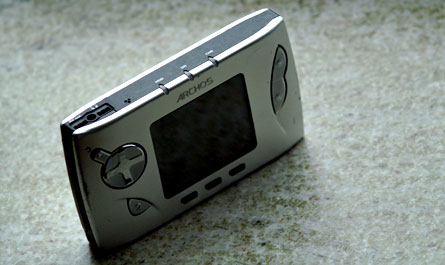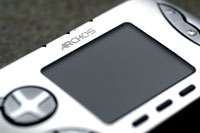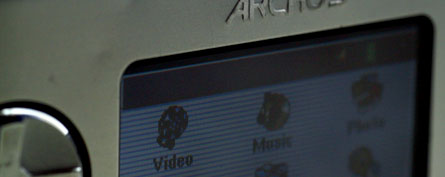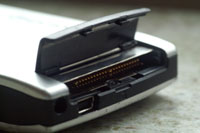







Archos Gmini 400
 The problem
The problem
Every photographer (plus dog) shoots digital these days. This leads to new and interesting logistical problems. Just a few years ago you could spend a weekend in the woods on just a set of lithiums and ten rolls of Provia, happy as a clam, but digital sucks a lot more battery juice -- and fills up memory cards. Few photographers have tens of gigabytes worth of storage space, as cards cost money. Especially fast and big cards. Enter the "image tank"; a portable hard disk drive which, at the price of a large Compact Flash card, can store many times a card's worth. In early 2005, I set out on a misson to find the best such device for my needs.
A somewhat unique device
There are lots of image tanks out there. Most consist of a Compact Flash slot (for your cards), a hard disk drive (for storage), a simple display (to indicate activity) and one or two buttons (to induce copying). That's great, of course, and solves the immediate problem of copying, but it's not much fun. What if someone offered something that could both copy memory cards and play music? An iPod for photographers, unlike the quite pathetic "iPod Photo". Well, someone indeed offers a device that let you copy your cards, listen to music, record sound, look at video, play games and God knows what else. Who could dream up such a device? Well, the French, of course.
Archos
Archos make some serious toys. They are the uncrowned kings of portable media players; with an impressive array of gadgets, they aren't focused on just mp3 music like most of the competitors but instead both image and sound. Several of their media players have Compact Flash slots for easy transfer to the internal hard disk drives, much safer and faster and less battery-sucking than trying to feed the hungry image tank from the mother ship (your camera) through a USB cable. Most of the "media capable" units have huge screens suitable for watching video.
The Gmini 400
 This specific device is one of the smallest in the Archos family, and also the smallest sporting a colour display. It packs a 20 GB (1.8 inch) internal hard drive, 2.2 inch screen, a non-removable internal Li-Ion battery and a CF card slot in a casing slightly larger than that of an iPod Photo (but twice as thick as an iPod Video). It comes with a universal charger usable in all parts of the world, assorted audio/video connectivity cables, and a feature list weighing more than the player itself. The silver parts of the shell seems to be made of steel or brass; the black parts are plastic. The buttons are metal. The screen is protected by a thick layer of plastic.
This specific device is one of the smallest in the Archos family, and also the smallest sporting a colour display. It packs a 20 GB (1.8 inch) internal hard drive, 2.2 inch screen, a non-removable internal Li-Ion battery and a CF card slot in a casing slightly larger than that of an iPod Photo (but twice as thick as an iPod Video). It comes with a universal charger usable in all parts of the world, assorted audio/video connectivity cables, and a feature list weighing more than the player itself. The silver parts of the shell seems to be made of steel or brass; the black parts are plastic. The buttons are metal. The screen is protected by a thick layer of plastic.
When turning on the player, you are almost immediately reminded of the players roots. It's very... French. Now what does that mean? Well, think of an older French car... for example, a CitroŽn. What's the most prominent feeling when sitting in the driver's seat? Right, wondering who has placed all these strangely shaped unmarked buttons and levers at awkward places, probably as some bizarre joke meant to torment the non-French parts of the world in general and English-speaking parts in particular. But I digress. Suffice to say, the button interface is not intuitive, but easily enough learnt after consulting a manual.
Non-photo related features
This gadget is not an image tank with built-in MP3 player; it's chiefly a media player with CF-reading capability. Thus, let's look at (sic) the sound first. The player supports WMA, MP3 and WAV, but sadly not the high-quality compressed format Ogg Vorbis (no software update for this is planned). Several playback modes are supported (repeat/shuffle/single play) but the modes aren't easily switched between. Playlists can be made in the device or in the computer (m3u format supported), and the Gmini also looks through and indexes all new files at startup to give you the ability to sort on artist, album, genre and lots of other things. Music, as well as video, is imported to the player by just plugging it into a computer and copying in Windows/MacOS/Linux/whatever. The sound is absolutely excellent; powerful, with good tonality, and no hiss or noises disturbing the music even at high volume.
 It also plays video. It has a so-so screen for video use -- it's small, and only one person can look at a time, which is reinforced by the surprisingly bad viewing angle of the screen. Video must be in DivX/XviD/MPEG4 format, and should ideally be converted to "Gmini compatible" by a supplied utility (which doesn't work with all movies). This conversion takes time! When everything is finished, though, playback is smooth and with good quality, even on a television set. Yes, you read that right, you can use a supplied adapter and get video out (plus stereo sound). You cannot record video, though, something the larger Archos units are able to do.
It also plays video. It has a so-so screen for video use -- it's small, and only one person can look at a time, which is reinforced by the surprisingly bad viewing angle of the screen. Video must be in DivX/XviD/MPEG4 format, and should ideally be converted to "Gmini compatible" by a supplied utility (which doesn't work with all movies). This conversion takes time! When everything is finished, though, playback is smooth and with good quality, even on a television set. Yes, you read that right, you can use a supplied adapter and get video out (plus stereo sound). You cannot record video, though, something the larger Archos units are able to do.
It also has a "game engine" from Mophun. This is a nice touch, but you'll have to buy all games you want to play, and they are not very fun or addictive. You also cannot use Mophun games intended for other devices, such as some Sony Ericsson mobile phones. Games are playable on an external TV screen just like the video.
Another prominent function is audio recording. The Gmini has a built-in microphone, mono, with low quality, and no auto-level function. This feature is only usable for quick memos, of which you of course can store zillions in crappy 8-bit quality. But if you attach the adapter you'll get stereo line in, and if you dig around in the menus you can set the recording to 16-bit PCM stereo and voila: a capable hard disk recorder for tapping sound out of a mixing board, for example. Writes uncompressed WAV. Still no manual recording volume though. Recording quality is good.
Last but not least, a corded remote control is available. This item gives the device some new functions; except for the remote buttons and lit display, it sports a FM radio, which is powered from the device and feeds its sound into it. You can define presets, and record sound from radio if you want. Recording options are as of above. The remote is unfortunately very cheaply and cheesily made, and very impressively has a worse interface than the actual device. As in most small devices, radio reception isn't great. Well, you can't have it all, I guess.
Photo related features
Of course, the major feature is an actual Compact Flash slot. Lots of similar devices nowadays have a function known as "USB host"; they can simulate a computer and get data from the camera using a normal USB cable. The problem with this is threefold:
 When inserting a Compact Flash card in the slot, the device automatically detects it and enters "copy mode". This overrides all other operating modes, and you cannot listen to music while copying, for example. You choose the source and destination in two panels, and then start the copying. Only card-to-disk copying is supported. When ready, simply remove the card to exit the file copying mode. It's very simple and very fast. "Verify" operation, where the source is compared to the copy after copying, is not supported.
When inserting a Compact Flash card in the slot, the device automatically detects it and enters "copy mode". This overrides all other operating modes, and you cannot listen to music while copying, for example. You choose the source and destination in two panels, and then start the copying. Only card-to-disk copying is supported. When ready, simply remove the card to exit the file copying mode. It's very simple and very fast. "Verify" operation, where the source is compared to the copy after copying, is not supported.
Copying a one gigabyte SanDisk Extreme III card takes six minutes. That is very fast, up there with the best dedicated devices.
When the images are on the hard disk, you can look at them... if you are patient. The low point of this device is the image viewing capability. You can zoom in images, get thumbnail-views and all you can expect, but JPEG decoding is horribly, painfully slow, bordering on totally unusable. Only JPEG is supported, not RAW formats.
Wrapping it up
So, there you have it, a small, solid mp3 player with good Compact Flash support. Add to that a few nice extras such as video playing, audio recording, and game playing. It is competent at most things, especially the things that count: file copying and music listening. It is simply a pretty well-rounded device, and I like it very much.
Go for the old one
Beware, though -- Archos have recently "upgraded" the Gmini 400 to the "Gmini 402". It comes in two versions, with or without built-in zoom-less 1.3Mp camera, and the most visible change in this new version is the elimination of the CF slot. Yes, you read that right; the new version is just another iPod, which admittedly adds USB host mode for camera transfers, but as we have established above this is much inferior to a real CF slot. So, in essence, Archos took the very thing that made this device unique and removed it to create a truly uninspiring device. Way to go, Archos. The old version can still be found, however.